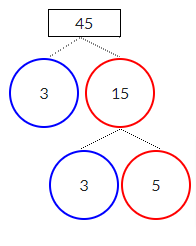Prime Factorization is the method of breaking down a given number in terms of its prime factors. If a number occurs more than once in the factorization then we will express in terms of powers to make it look more compact. Prime Numbers are the numbers that have factors 1 and itself. On this page, we have explained the definition of prime factorization, different methods of prime factorization, solved examples on finding the prime factors, etc. in detail.
Also, See:
What is Prime Factorization?
It is the process of writing the given number as a product of prime numbers such that the original number is evenly divisible by these factors. Method of Prime Factorization is performed on composite numbers to factorize them and find the prime factors. We can use this technique to find both HCF and LCM of a Given Set of Numbers.
For Example:
Prime Factorization of 18 is 2x3x3; we can write it as 2×32
Prime Factorization of 32 is 2x2x2x2; we can write it as 24
Prime Factors of a Number
Prime Factors of a Number is the set of prime numbers that when multiplied together results in the actual number. Prime Factors divide the number completely and is similar to factoring a number. However, we will consider the prime numbers among the factors. Example: Prime Factors of 25 are 5 and 5.
Prime Factorization Methods
There are two methods of Prime Factorization of Numbers. They are as such
- Division Method
- Factor Tree Method
Prime Factorization through Division Method:
Follow the simple steps provided below to find the prime factors of a number using the division method. They are along the lines
- Divide the given number by the smallest prime number and the smallest prime number should be divided exactly.
- Later, divide the quotient with the smallest prime number.
- Continue the process until you get a quotient of 1.
- Later, multiply all the prime factors.
Example:
Perform Prime Factorization for Number 260 using the Division Method.
Solution:
Below is the step-by-step process of prime factorization of 260 using the division method.
Step 1: Divide 260 with the least prime number 2
260÷2 = 130
Step 2: Next divide the quotient with the least prime number
130÷2 = 65
Step 3: Later, divide the quotient with another least prime number 5.
65÷5 = 13
Step 4: As 13 is a prime number that has factors 1 and itself.
Now, the prime factorization of 260 is expressed as 2*2*5*13
Prime Factorization using Factor Tree Method:
Go through the below-provided guidelines in order to write down the prime factors of a number using the factor tree method. They are as under
- Write down the given number as the root of the tree
- Next, write down the factors of the number as branches of the tree.
- And then factorize the composite numbers and write down the factor pairs as the branches.
- Continue the process until you get all the prime factors of the composite numbers.
Example:
Do Prime Factorization of 45 using Factor Tree Method?
Solution:
45 is factored into two factors 3 and 15. 15 is again factored and written as factors of 3 and 5.

On writing the prime factors of 45 we have 3*3*5.
Examples of 2 Methods of Prime Factorization
Example 1.
Find the Prime Factors of 1040 using the Factor Tree Method?
Solution:
Note down the number 1040 as the root of the tree structure. Firstly, find the factors of 1040 and write down them as branches. Since 520 can be further expressed as factor pairs of 2 and 260. Continue the process till the numbers are all prime. Below Tree Structure is formed for number 1040.

Prime Factors of 1040 are 2*2*2*2*5*13.
Example 2.
Find the Prime Factors of 440 using the Division Method?
Solution:
Below is the step-by-step process of prime factorization of 440 using the division method.
Step 1: Divide 440 with the least prime number 2
440÷2 = 220
Step 2: Next divide the quotient with the least prime number
220÷2 = 110
Step 3: Later, divide the quotient with another least prime number 5.
110÷5 = 22
Step 4: Now divide 22 with the least prime number.
22÷2=11
As 11 is the prime number that has factors 1 and itself.
Now, the prime factorization of 440 is expressed as 2*2*5*2*11
FAQs on Prime Factorization Methods
1. What is meant by Prime Factorization Method?
Prime Factorization is the process of writing the given number as a product of prime numbers which when multiplied together results in the original number.
2. What are two methods for finding the prime factorization of a number?
There are two methods for finding the prime factorization of a number. They are as such
- Division Method
- Factor Tree Method
3. What are the Prime Factors of 12?
Prime Factors of 12 are 2, 2, 3 and we can express it as 2*2*3.
